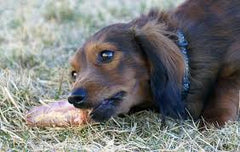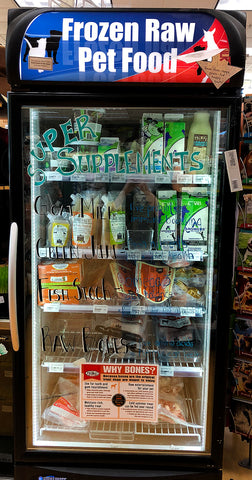
Giving your dog a bone is a tradition in many pet households. Dogs have a natural urge to chew, and bones satisfy that need while helping to clean and scrape their teeth all the way up to their gums, making them a great option for treat time.
Domesticated dogs still share 90% of their DNA with wolves and still maintain the same set of molars and extremely strong jaws that were designed to crush and chew bones in the wild. Raw bones provide them with a safe bone to gnaw and crush to their hearts content while providing them with healthy amino acids, iron, and calcium.
Sounds cool, what are they?

Raw bones are found in the freezer and come in two main varieties: recreational style bones and “meaty” bones.
Recreational bones are either marrow bones (which come in varying sizes) or femur bones (great for larger dogs). These are similar to the traditional smoked bone, and your dog should not consume the outside of the bone, only the soft marrow inside. Recreational bones are approved for dogs only and have very little meat left on the bone itself.
Recreational raw bones enhance your dog’s teeth, gum, and jaw health. These bones do not need to be thawed out ahead of time (at most, partially thaw up to 30 minutes) and should always be fed with supervision. The bone should be large enough that your dog cannot get the entire thing into its mouth at once, as this can lead to trying to swallow the bone whole.
These bones are often more enticing than the classic smoked or cooked bone because they still have a bit of meat on them and the marrow is soft enough that your dog can get all of the great amino acids that marrow produces. A wonderful option for picky dogs or dogs that tend to get bored quickly with their toys or treats! Being left in their raw form also ensures that there is no chipping or splintering bone that may harm your pet.
Meaty bones, such as chicken backs or turkey necks, are much fattier and are meant to be completely consumed; the bones inside do not splinter. These can serve as an entire meal replacement or part of a raw meal for a pet, so be sure to adjust your dog or cat's calorie consumption for the day.
Raw meaty bones are different from what we traditionally think of as a bone. These are parts of the animal that can be consumed whole and provides your dog (or cat!) with bio-available nutrients that help their hips, joints, skin, and coat, as well as their oral strength!
Give Your Cat a Bone
You read that right, meaty bones are approved for cats too! Cats are obligate carnivores and their teeth are designed to tear meat from the bone. These bones will help clean your cat's teeth through the scraping that occurs while they eat.

Cats are often finicky when it comes to eating new textures or styles of food, so introducing bones can be a challenge. Introduce it in small pieces and introduce it through hand feeding. Next, place it at the bottom of your cat's bowl and cover it with the typical meal. They will get the idea that it, too, is food and it will smell familiar.
Safety First
While raw chicken and turkey can pose a bacterial risk to humans, these bones are processed using a method called High-Pressuree Processing (or HPP), which uses extreme amounts of water pressure to “burst” bacteria bubbles such as e-Coli, listeria, or salmonella. The meat is kept at -40 degrees and the integrity of the raw meat remains unchanged. The marrow bones are all tested and held for safety approval.
This step means the meaty bones are safer to feed while raw than food bought at the grocery store. Grocery stores expect that humans are taking their food home to cook it and, therefore, do no preliminary bacterial kill steps beyond the normal health and safety standards.
Raw bones are soft enough to indent with your fingernail and are safe to feed. The small bones will break down into calcium and will not scrape their esophagus or stomach lining if consumed whole. While cooked chicken and turkey bones are a risk, raw bones do not.
Feeding raw bones can be a bit different than a more traditional chew. If feeding inside, try using a towel to keep your pet contained or feed it in a bathtub. That way your pet should stay in one place while eating the treat and you can easily sanitize the area. If you have access to a yard or outside patio, try feeding raw bones outdoors.
Sign me up, where can I find them?
You will find our entire selection of raw bones in our bone freezer!



